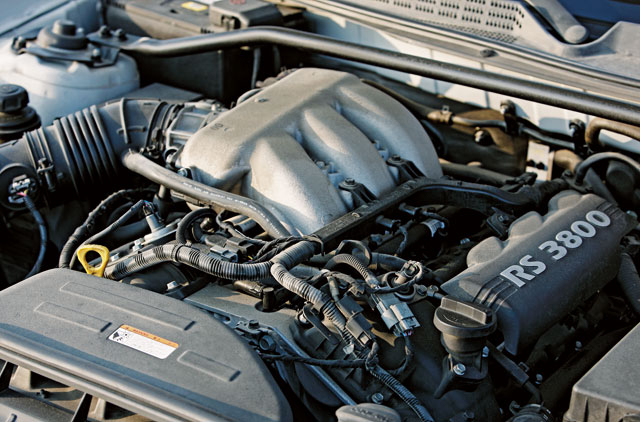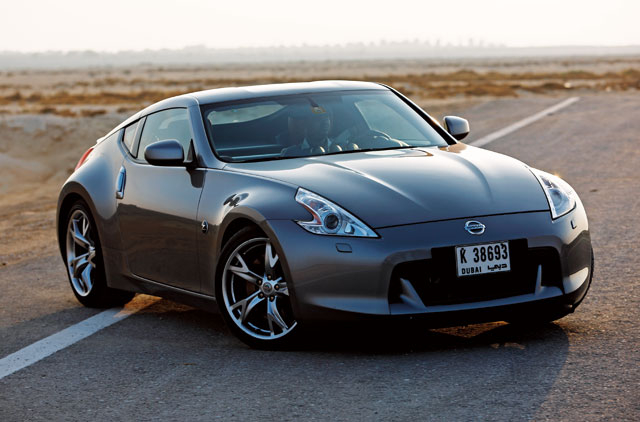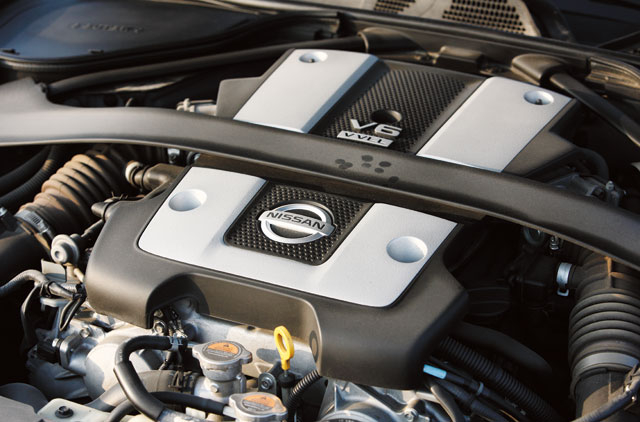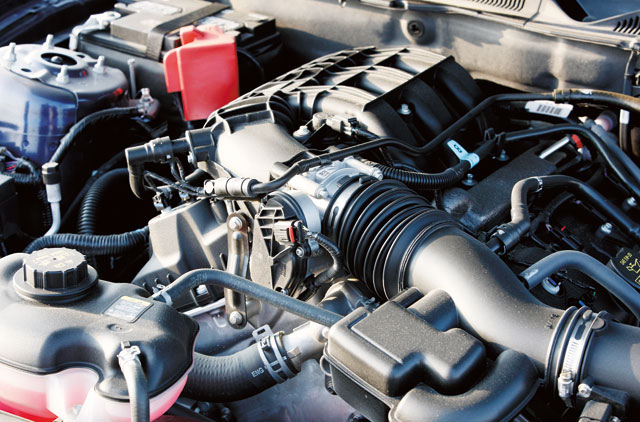In Europe, American cars are hard to come by. In America, so many Continental brands aren't even represented; all the French manufacturers, the Italians (soon to return though), Seat, Skoda, Opel/Vauxhall… Elsewhere in the world, badge engineering is rife, where a Suzuki might be a Chevy, a Chevy is a Holden, a Nissan is a Renault, and a Renault is a Dacia…
Meanwhile, we in the GCC pretty much have it all. Americans, Europeans, Asians (including even the Chinese marques), and would you believe it, a few Australians too, in the case of, for example, the CSV CR8 and Caprice.
But it seems that even the GCC is starting to realise that maybe it's not such a good idea to throw money into the pumps. And if anything, the previous two years have taught us that cash doesn't, in fact, grow on trees. Maybe a V8 isn't an absolute necessity, the only way to save face in your neighbourhood. And it's true. With the onset of modern and efficient V6 engines, you get all the useable performance you need, along with less frequent fuel pump stops and most of all, more change left in your pocket due to the lower purchase price.
We gathered the three best and latest affordableV6 sportscars in a twisty-ish part of the desert and didn't even need to stir the pot — the fight escalated all by itself.
Sony's Hyundai Genesis Coupé
Sacrilege! This would have been anyone's response on seeing the picture on the cover if it had been a few years back. If there is someone out there who feels that way even now, we wouldn't be surprised. Because saying the name Hyundai in the same breath as Mustang or Z-car would in itself amount to irreverence to a lot of car lovers. Little wonder then if it's considered the utmost form of profanity to pit an upstart coupé from the Korean carmaker against a pair of the most celebrated two-doors in automotive history.
Agreed, despite being one of the largest carmakers in the world, Hyundai does not have much tradition apart from churning out boring unreliable commuter boxes for decades. Nor can it boast of a cult following for any of its models like the Mustang and the Z. But, as the wise saying goes, ‘a journey of a thousand miles begins with a single step'. And that single step for Hyundai is the Genesis Coupé. When it launched its rear-wheel drive saloon in 2009, no one expected the car to be the resounding success it turned out to be, thereby laying a solid foundation for the Coupé that came a year later. It also gave Hyundai the courage to announce that they were indeed gunning for icons like the Nissan 370Z and the Ford Mustang. Surprisingly capable and priced right, the Genesis Coupé did just that in the US and elsewhere, slowly eating into the market share of its legendary rivals.
I remember calling the Genesis Coupé a ‘handsome' car the first time we featured it in the mag, which was early last year. Indeed, it is a good looking car with its aggressive stance, the stylish 19in alloys and sharp lines that add character to its sporty profile. But, when parked beside the Z and the refreshed 2011 Stang, the Hyundai pales in comparison. Also, the great work done by the designers has been somewhat spoiled by the choice of shiny hard plastics for the interior. These austerity measures are obviously not justified anymore in a Dh115,000 car as the Mustang, which is just Dh5K more, offers an infinitely plusher and more sophisticated cabin. However, you'll be willing to overlook all these minor quibbles once the 3.8-litre V6 purrs into life.
The exhaust note isn't that great, it's even a bit soggy compared to the other two, but is gruff enough to hint at what the 299 horses are capable of when unleashed. The real surprise comes when you put the six-speed auto into Drive and floor the pedal. The coupe's giddy acceleration, robust throttle response and precise handling combined with 361Nm of torque offer a spirited driving experience that makes it more than a match for its rivals. The steering feels naturally weighted around corners and communicates the subtlest nuances on the road surface to your hands. The suspension is firm, but not rigid to the point of making it skittish over rough patches. In fact, when you're not flogging it, the Coupé's shocks are pliant enough for a fairly comfortable highway cruise. Although the Brembo brakes do their job pretty well, it's unfortunate that the pedal feels a bit sodden making the driver less confident than he should actually be.
Overall, the Genesis Coupé is a true sportscar in every sense of the word. And it's a brilliant start from the Korean company to building up a high performance heritage that'll one day make Genesis a name as glorious and illustrious as the Mustang's or the Z's.
Dejan's Nissan 370Z
The original Z captivated its audience not only because it offered Japanese muscle at a discount, but because it looked as good as it did. And the reason why it looked so pleasingly svelte, is its L24. The 2.4-litres of Datsun displacement were laid out straight down the line, six poppers fed by two side draught SU carburettors to whip around 150 horses to the rear wheels. This long, narrow engine called for a tapering, slender bonnet. And that's basically where it began, with the styling just as elegant towards the back of that original 240Z.
This new 370Z, well, it only looks like a Nissan with a V6. And that's the problem, that V. Of course Nissan had to use the VQ37 engine — which in some form or another has been doing the firm justice since 1994 — because basically they didn't have any choice. But I, along with the rest of the world's petrolhead fraternity, would've happily settled for the legendary RB straight-six of any capacity or aspiration.
Well too bad, the VQ is what we've got, and it's the reason why the entire 370Z isn't exactly a looker. Fine, there are some great details scattered all over its bodywork, but the proportions are too stumpy, the bonnet line too high, the rear window is almost a sunroof and consequently visibility is horrendous.
So what's going on here? This is a Z-car for crying out loud, one of the most legendary nameplates in motoring history… Where did it all go wrong?
It's not actually all that bad, it's just that since it's been launched, more and more accomplished coupés have flooded the market and made the 370Z take a step down the rankings. The old 350Z was probably the ultimate bang-for-buck Japanese sportscar on sale during its time, but this one costs Dh191,000. Bluntly, that's way too much.
You do get a wildly-improved interior, with sweet orange seats, a stocky steering wheel, and the best gearchange paddles in any territory (they're so large they don't even need to turn with the wheel, possessing a mechanical sharpness making the 370Z a delight in manual mode). But inside a 370Z, it's cramped. It's the only car here without any back seats whatsoever (you get a bulky chassis brace instead), but even so, front passenger room is minimal. The seats adjust electronically although you'd need to be quite gifted in your body build to find the perfect driving position — there's no telescopic wheel adjustment. Also, changing lanes is a leap of faith due to the 370Z's blind spots.
Nissan added some performance gauges too, although two of them show you your voltage and the time, so it's more gimmicky than functional. Does this car know what it is? Start the engine and the first impression is, yes, yes it does. With 332bhp from a 3.7-litre V6 gushing to the rear Bridgestones through that seven-speed paddle shift transmission, this has its rivals well and truly embarrassed in the ‘mine's bigger than yours' argument.
The power comes in at 7,000rpm, but somehow all seven ratios have plenty of pull from any speed, even if the 366Nm of torque come in from 5,200rpm. The 19in rubber wraps some striking Rays Engineering rims, no less (it says so in big stamped letters on the rims themselves; at least Nissan lets you know where all that money is going). But pulling off with just a smidgen of wheelspin, despite a heavy right foot, soon starts to unravel the car's story. You can switch the electronics off, but not all the way off, which means you're wasting your time if you show up at a local car meet and try to impress girls with your manly doughnuts. The 370Z can pull maybe half a doughnut and a pathetic little wheezy two-foot burnout, at which point the electronics realise you're being a hooligan and cuff you.
However, once you leave the car park and actually start driving, the Z turns into a maniac. Its steering disguises the lack of front-tyre communication by adding unnecessary weight, so you're left with getting all your feedback from the bottom of your seat through the chassis, which is fine. But the suspension is so rigid, and the tyres so low-profile, that you get only a minimal amount of data fed to the system. More of it comes from the sounds of the squirming rubber than the actual sense. The engine note doesn't help either. It sounds like a blender with plastic blades. Sitting inside it's also extremely muted, so that the transmission whine makes itself much more apparent.
But devouring corners is its speciality — as long as you hold on dearly and ready yourself to catch its tail (it's always waiting to kick out), you can simply demolish roads in this car. Body roll is not in its lexicon, neither is squat, dive or understeer.
Oversteer, though, that's pretty much the first word the 370Z ever uttered. It takes much more skill at the limit than the other two, but doesn't reward as it consequently should. Maybe it's because it's so highly strung and demanding. If you want speed in this Nissan, you need to sacrifice so much; comfort, feel and feedback, visibility, confidence with its extremities, precise road placement… There are things that the 370Z makes very difficult for the driver. Its nervousness could also be attributed to the short wheelbase — a tiny 2,550mm against the Hyundai's 2,820mm and Ford's 2,720 — and then again, we have to ask ourselves why exactly does a Nissan need Ferraris-spec tyres? The 370Z, I'm afraid, tries to take too big a bite without considering whether it can swallow.
Imran's Ford Mustang V6
Nothing burns rubber quite like a Mustang — even if it's ‘only' got a V6 under that pumped up bonnet. Being a V8 kind of guy and having driven the wonderful 5.0 with that muscular growl and superb performance, I was interested to see how it would fare with two cylinders lopped off. I knew it would be more economical, but I'm not really bothered about miles per gallon — it shouldn't come into the equation when buying a proper muscle car. Give me the days when just firing up an old Yank tank would use a gallon of fuel. However, we've come on quite a bit from those early days of the breed, and Ford's new 3.7-litre powerplant is a perfect example. It can get you 31mpg on the highway even when it's mated to a six-speed automatic. That's a huge improvement on 18-20mpg, which is roughly what you'd get from the first generation cars.
But, does the Mustang's performance suffer with a smaller engine? Not when you compare it to the previous 4.0-litre SOHC V6 which was good for a meagre 210bhp. The new all-aluminium DOHC 24-valve engine, with variable valve timing, delivers a ludicrous 305bhp at 6,500rpm and 380Nm of tyre melting torque at 4,250rpm. This V6 has more than enough bite to back up its bark which begins with a menacingly deep growl when you turn the key. You just know this thing means business.
The mesmerising Kona Blue metallic paint on our test car is arguably the best colour to have ever adorned that brutish body. It manages to accentuate the Mustang's curves and makes it look even more ripped than it actually is. The colour also seems to make the rear end look tighter while the angry front looks like it'll gobble you up and spit you out of the new dual exhausts. The 18in alloys add to the brutish nature. And that throaty roar from the pipes is almost as thrilling as the big 5.0's. Usually, the feeble sound of a V6 makes me want to punch something, but this engine sounds raw and angry every time you hit the throttle. There's no need to drown it out by blasting up the Shaker 500 audio system.
Just when you think it can't get any better, it does, and how. The tan-leather interior, stitched to perfection, is pure class. There's something about this shade which is absolutely priceless. It's as if you have a saddle for a seat, albeit much more comfortable, which can be electrically adjusted six-ways. There's a built in camera in the rear view mirror, ambient lighting in all the nooks and crannies, scuff plates and pedal covers.
All the gauges are crystal clear and simplistically laid out. Ford went for a straightforward design, mimicking the retro style of the original car and they've done a wonderful job in here. It didn't have the optional glass roof, and as a result, back seat passengers might find it claustrophobic. That is if you can actually convince someone to get in back, in the first place.
It's sharp and well-balanced and proves to be remarkably fun to chuck into the twists — and you don't hear that too often with American cars. It's quite nimble for its size (188.1in long, 73.9in wide and 55.6in high) and 1,575kg weight while the feedback from the three-spoke, electric power steering is surprisingly good. The suspension has been tuned to absorb most potholes and even on narrow comfort tyres, it manages to follow the others into corners at high speeds. There was hardly any fade in the four-wheel discs after a full day of rigorous tests in the desert, which bodes well if you plan on taking this car for regular workouts at the track.
Essentially, what we have here is an old school muscle car (it has a live rear axle) with a new-age, and dare I say, economical engine, that won't burn a hole in your pocket. The Mustang is, was and unless they do something radically different with the suspension set up, will always be a car out to have as much fun as it can have. It's not often that you get something that is powerful, affordable and truly exciting to drive.
The 5.0 with 412bhp is for the serious racer, but this V6 will keep the masses extremely satisfied. There aren't many better ways of getting to work than this.
Verdict
The price range of these three would make you think the Ford is a four-pot econobox and the Nissan a twin-turbo all-wheel drive luxury coupé bashing heads with Porsche's Boxster.
In actual fact all are remarkably similar and each provides heaps of fun, but unfortunately the Nissan has to be the first to go. It has improved on its predecessor in some ways, but forgot to keep the 350Z's raucous and intuitive nature. This 370Z is raucous all right, but never involves the driver, alienating him with its bleak sound, electronic confusion and harsh ride. The Hyundai, on the other hand fails to deliver on the interior front, and its styling is hit and miss. The front and rear ends look like they came off the discount shelf, but you move to view the profile and suddenly the Genesis Coupé is a beauty. Then you drive it, and you wouldn't believe Hyundai is the same company that used to build the Tiburon. The steering is crisp, the RWD chassis hugely compliant and although the engine isn't a masterpiece, it's great at doing cruises too. An absolutely fantastic first sportscar effort from the Koreans, and we can't wait until the next one — that should leap to the top of the pile.
For now though, the latest entry-level Ford Mustang proves itself as the winner, housing an amazing powerplant with the spirit of a V8 and economy of a V6... Sounds great, rides smooth, drifts to your heart's content and get this; spec a manual and you can have it for Dh99,000. And that's before you even start bargaining!
Tech sheet
Hyundai Genesis Coupé: The upstart
1 The all-aluminium 3.8-litre V6 engine's 299 horses come alive at 6,000rpm and 361Nm of torque is available at 4,700rpm.
2 There's no sat-nav, but the clearly laid out display screen shows outside temperature, audio system information and climate control settings.
3 The Genesis Coupé uses the same rear-wheel drive architecture developed for the Genesis saloon.
4 It uses a MacPherson strut dual-link front suspension and a five-link rear suspension setup.
5 The 19in Hyper Silver alloys wear 225/40R19 rubbers up front and 245/40R19s at the back.
Nissan 370Z: The wild child
1 Nissan kicked off its VQ series way back in 1994, but direct injection is still in the pipeline for this VQ37VHR.
2 Seven-speed tranny features downshift rev-matching, and manual mode shifts take just 0.5 seconds. The 370Z is the only car here with paddle shifters.
3 Aluminium body panels help lower overall weight to 1,483kg, which is highly commendable and a lot better than Hyundai's 1,540kg and Ford's 1,575kg.
4 Nissan 370Z's chassis is the most taut of the lot, incorporating an underbody V-bar to reduce rear lateral bending.
5 All GCC cars come with 19in Rays forged aluminium wheels with Bridgestone Potenza 275/35 rear tyres.
Ford Mustang V6: The dark horse
1 The 3.7-litre V6 features cold air induction which delivers a cold, dense intake charge to the cylinders that helps boost horsepower.
2 The Microsoft Sync system allows you to make hands-free calls, control your music with voice commands and gives you traffic updates.
3 Each signal chamber has LEDs which sequentially light up from inside to out.
4 The 2011 Mustang V6 features new, dual exhausts which emit a roar almost as fierce as the legendary 5.0.
5 AdvanceTrac electronic stability control gives you more control in slippery road conditions.
Specs
Model Genesis Coupé
Engine 3.8-litre V6
Transmission Six-speed auto, RWD
Max power 299bhp @ 6,000rpm
Max torque 361Nm @ 4,700rpm
Top speed 240kph
0-100kph 6.3sec
Price Dh115,000
Plus True sportscar, great value, fun factor
Minus Interior
Model Mustang V6
Engine 3.7-litre V6
Transmission Six-speed auto, RWD
Max power 305bhp @ 6,500rpm
Max torque 380Nm @ 4,250rpm
Top speed NA
0-100kph NA
Price Dh120,000
Plus Torque, flexible engine, smooth ride, value
Minus Chassis and handling
Model 370Z
Engine 3.7-litre V6
Transmission Seven-speed auto, RWD
Max power 332bhp @ 7,000rpm
Max torque 366Nm @ 5,200rpm
Top speed NA
0-100kph NA
Price Dh191,000
Plus Improved interior, taut chassis, transmission
Minus Too expensive, lost its sportscar edge

















